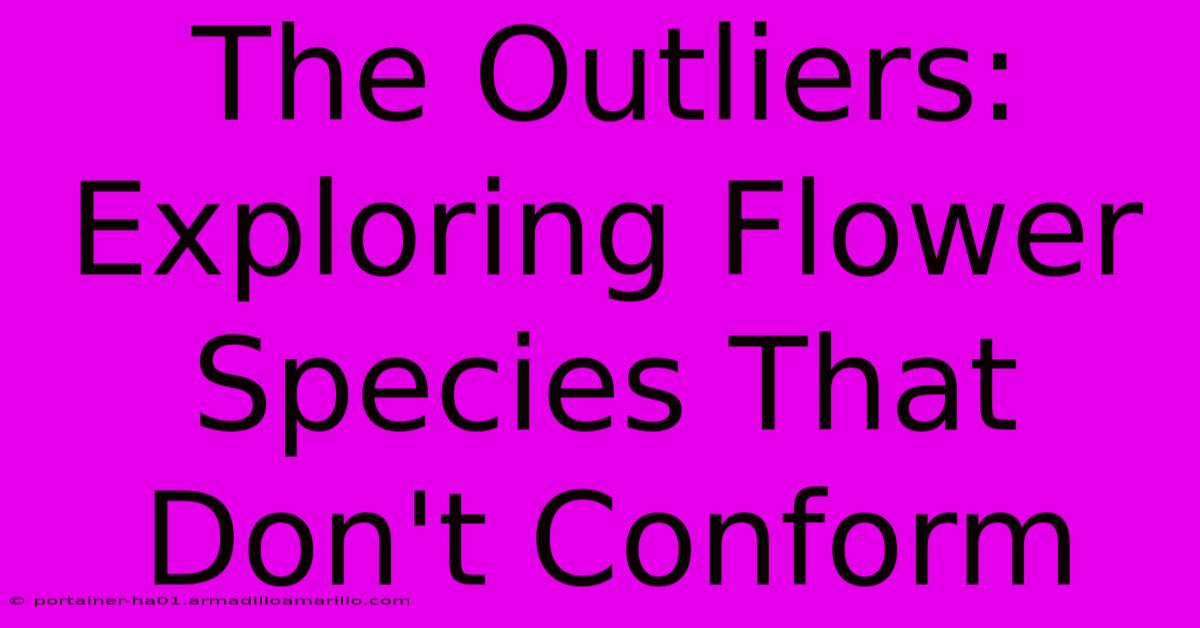The Outliers: Exploring Flower Species That Don't Conform

Table of Contents
The Outliers: Exploring Flower Species That Don't Conform
The world of flowers is a riot of color, shape, and scent, a breathtaking display of biodiversity. But within this stunning array, some species defy easy categorization, existing as fascinating outliers that challenge our understanding of floral norms. These botanical rebels, with their unique adaptations and unconventional strategies, offer invaluable insights into the power of evolution and the remarkable resilience of life. Let's delve into the captivating world of these floral nonconformists.
Beyond the Petal Paradigm: Unconventional Flower Structures
Most flowers adhere to a recognizable structure: petals attracting pollinators, stamens producing pollen, and pistils receiving it. However, some species dramatically deviate from this blueprint.
1. The Amorphophallus titanum: The Corpse Flower's Stinky Strategy
The aptly named Amorphophallus titanum, or corpse flower, is a prime example of an outlier. Instead of attracting pollinators with vibrant colors and sweet scents, this Indonesian native employs a different tactic: it emits a pungent odor resembling rotting flesh. This gruesome aroma attracts carrion flies and beetles, which inadvertently pollinate the flower. This unconventional strategy highlights the diverse ways plants have evolved to ensure reproductive success. Its unusual method is a powerful example of natural selection at work.
2. The Orchid Family: Masters of Deception
Orchids are renowned for their astonishing diversity, and many species exhibit remarkable adaptations. Some orchids, for example, mimic the appearance and scent of female insects to attract male pollinators. This deceptive strategy, known as sexual mimicry, is a testament to the flower's cunning evolutionary path. These orchids are true outliers, utilizing intelligence and trickery to ensure their survival.
Challenging the Pollination Norms: Beyond Bees and Butterflies
While bees and butterflies are commonly associated with pollination, many outlier flower species have developed relationships with less conventional pollinators.
1. Night-Blooming Cereus: The Nocturnal Pollinators
Many flowers open during the day to attract diurnal pollinators. However, night-blooming cereus (genus Selenicereus) opens its stunning blooms only at night, relying on nocturnal pollinators like moths and bats for pollination. Their adaptation to nighttime pollination exemplifies the incredible adaptability of flowering plants. This unique characteristic showcases the diversity of pollination strategies in the plant kingdom.
2. Bird-Pollinated Flowers: A Colorful Collaboration
While some flowers rely on insect pollination, others have co-evolved with birds. These bird-pollinated flowers often exhibit bright red or orange colors, which are particularly visible to birds. They also tend to have strong, sturdy structures capable of withstanding the weight of avian visitors. This specialized co-evolution showcases another remarkable outlier strategy. The strong, vibrant flowers are well-adapted to their specific pollinator.
The Importance of Outliers in Understanding Floral Evolution
Studying these unconventional flower species offers crucial insights into the evolutionary processes shaping plant diversity. Their unique adaptations highlight the remarkable plasticity of life and the various strategies employed to survive and reproduce in diverse environments.
Understanding these outliers broadens our understanding of the intricate relationships between plants and their pollinators and the driving forces behind plant evolution. By studying these botanical rebels, we gain a deeper appreciation for the complexity and wonder of the natural world. The ongoing research on these species continues to unravel the secrets hidden within their unconventional forms and functions, promising a deeper understanding of biodiversity and the amazing power of nature.

Thank you for visiting our website wich cover about The Outliers: Exploring Flower Species That Don't Conform. We hope the information provided has been useful to you. Feel free to contact us if you have any questions or need further assistance. See you next time and dont miss to bookmark.
Featured Posts
-
Embrace Riverfront Bliss Parkside On The Rivers Unforgettable Views
Feb 06, 2025
-
Font Alchemy Crafting Custom Fonts That Captivate And Convert
Feb 06, 2025
-
Say Goodbye To Compatibility Issues Effortlessly Convert Word Docs To Google Docs
Feb 06, 2025
-
Unlock The Secrets Of A Triptych A Masterclass In Art And Narrative
Feb 06, 2025
-
The Silver And Blacks Secret Weapon Meet The Mysterious Raider Rush
Feb 06, 2025
